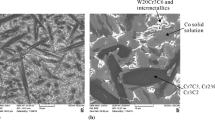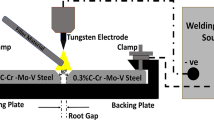Abstract
Cemented carbides are hard and brittle materials. Their material properties are adjusted by their chemical composition, in particular their average hard phase grain size and their binder fraction. The research paper focusses on grinding of cemented carbides with cobalt (Co) as binder and tungsten carbide (WC) as hard phase material. Within the research paper, it is discussed if and to what extent the cemented carbide composition affects the occurring thermo-mechanical load collective in the grinding process. In particular, the influence of the average WC grain size and the cobalt fraction on the thermo-mechanical load collective is investigated and explained by the cemented carbide material properties. The results of the publication contribute to a knowledge-based design of cemented carbide grinding processes.








Similar content being viewed by others
References
Denkena B, Köhler J, Schindler A (2014) Behavior of the magnetic abrasive tool for cutting edge preparation of cemented carbide end mills. Prod Eng Res Devel 8(5):627–633. doi:10.1007/s11740-014-0569-4
Kieffer R, Benesovsky F (1963) Hartstoffe. Springer Vienna, Vienna
Liu AY, Wentzcovitch RM, Cohen ML (1988) Structural and electronic properties of WC. Phys Rev B 38(14):9483–9489. doi:10.1103/PhysRevB.38.9483
Choi K, Hwang NM (2000) Effect of VC addition on microstructural evolution of WC–Co alloy: mechanism of grain growth inhibition. Powder Metall 43(2):168–172. doi:10.1179/003258900665943
Williams WS (1999) Electrical properties of hard materials. Int J Refract Met Hard Mater 17(1–3):21–26. doi:10.1016/S0263-4368(99)00005-0
Exner HE (1979) Physical and chemical nature of cemented carbides. Int Metals Rev (4):149–173. doi:10.1179/imtr.1979.24.1.149
Brevern P von (2008) Untersuchungen zum Seiten—Planschleifen von Hartmetall. Industrie-Diamanten-Rundschau 42(2)
Biermann D, Würz E (2009) A study of grinding silicon nitride and cemented carbide materials with diamond grinding wheels. Prod Eng Res Devel 3(4–5):411–416. doi:10.1007/s11740-009-0183-z
Kolaska H (ed) (1992) Pulvermetallurgie der Hartmetalle. Fachverband Pulvermetallurgie, Hagen
Hegeman J, Hosson J de, With G de (2001) Grinding of WC–Co hardmetals. Wear 248(1–2):187–196. doi:10.1016/S0043-1648(00)00561-5
Ren YH, Zhang B, Zhou ZX (2009) Specific energy in grinding of tungsten carbides of various grain sizes. CIRP Ann Manuf Technol 58(1):299–302. doi:10.1016/j.cirp.2009.03.026
Heymann T (2015) Schleifen und Polierschleifen von wendelförmigen Spannuten an Vollhartmetallbohrwerkzeugen. Dissertation, TU Dortmund
Zhan YJ, Li Y, Huang H et al (2009) Wear of brazed diamond wheel in grinding of cemented carbide. KEM 416:198–204. doi:10.4028/www.scientific.net/KEM.416.198
Luo SY, Liu YC, Chou CC et al (2001) Performance of Powder filled resin-bonded diamond wheels in the zvertical dry grinding of tungsten carbide. J Mater Process Technol 118:329–336
Acknowledgements
The authors would like to thank the German Research Foundation DFG for funding the depicted research within the research project KL 500/120-1. Furthermore, the authors would like to thank the company CERATIZIT for their support.
Author information
Authors and Affiliations
Corresponding author
Rights and permissions
About this article
Cite this article
Wirtz, C., Mueller, S., Trauth, D. et al. Influence of the cemented carbide specification on the process force and the process temperature in grinding. Prod. Eng. Res. Devel. 11, 633–641 (2017). https://doi.org/10.1007/s11740-017-0766-z
Received:
Accepted:
Published:
Issue Date:
DOI: https://doi.org/10.1007/s11740-017-0766-z




